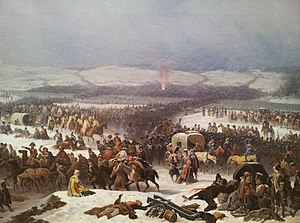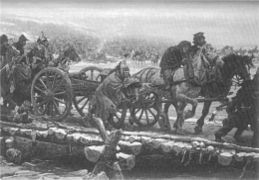Battle of Berezina
This article includes a list of general references, but it lacks sufficient corresponding inline citations. (January 2014) |
| Battle of Berezina | |||||||
|---|---|---|---|---|---|---|---|
| Part of French invasion of Russia (1812) | |||||||
 Napoleon's crossing of the Berezina an 1866 painting by January Suchodolski oil on canvas, National Museum in Poznań | |||||||
| |||||||
| Belligerents | |||||||
|
|
| ||||||
| Commanders and leaders | |||||||
|
|
| ||||||
| Strength | |||||||
|
49,000 combatants, 40,000 stragglers[3] |
64,000 combatants Chichagov: 34,000; Wittgenstein: 30,000.[3] | ||||||
| Casualties and losses | |||||||
|
13,000–25,000 combatants 10,000–20,000 stragglers 25 cannons | 6,000–20,000 combatants | ||||||
Template:Campaignbox Napoleon's invasion of Russia
The Battle of Berezina (or Beresina) took place from 26 to 29 November 1812, between the French army of Napoleon, retreating after his invasion of Russia and crossing the Berezina (near Borisov, Belarus), and the Russian armies under Mikhail Kutuzov, Peter Wittgenstein and Admiral Pavel Chichagov. The battle ended with a mixed outcome. The French suffered very heavy losses but managed to cross the river and avoid being trapped. Since then "Bérézina" has been used in French as a synonym for "disaster."
Background
As the surviving masses of the Grande Armée struggled on for the perceived safety of the west, the Russian armies closed in on them.
The French had suffered a defeat just two weeks earlier during the Battle of Krasnoi. However, reinforcements who had been stationed near the Berezina during Napoleon's initial advance through Russia brought the numerical strength of the Grande Armée back up to some 30,000 to 40,000 French soldiers capable of fighting, as well as 40,000 non-combatants. The Russians had approximately 61,000 troops at the Berezina, with another 54,000 under Kutuzov just 40 miles to the east who were approaching the river.
Battle and crossing
Napoleon's plan was to cross the Berezina River and head for Poland, while his enemies wanted to trap him there and destroy him. The original plan to cross the frozen river quickly proved impossible, as the usually frozen waterway had thawed and was now impassable.
The nearby bridge at Borisov had been destroyed and most of the equipment to build a pontoon bridge had been destroyed a few days earlier. Fortunately for the French, the commander of the bridging equipment General Jean Baptiste Eblé had disobeyed Napoleon's earlier order to abandon equipment, instead retaining crucial forges, charcoal and sapper tools and thus only needed protection from Chichagov's force on the far west bank to span the river.[4]
Marshal Oudinot was given the task of drawing off the admiral and made a move towards the south. The plan worked, and Eblé's Dutch engineers braved ferociously cold water to construct the vital 100-metre bridge. Hypothermic death in less than 30 minutes of exposure was likely. The four Swiss infantry regiments acted as the rearguard. Cavalry quickly crossed it followed by infantry to hold the bridgehead. The Swiss suffered terrible losses (of the four Swiss Regiments of Oudinot's corps, only 300 soldiers survived), but managed to cover both positions and the retreat. This struggle is depicted in the Beresinalied. The Swiss's heroic stand saved most of the French troops.
A second structure opened within hours and cannons were taken across it to bolster the defensive perimeter. They arrived just in time, as Chichagov realised his error and attacked the 11,000 French troops.
By midday of the 27th, Napoleon and his Imperial Guard were across, and the strategy now swung to saving the Swiss rearguard, which was fighting against Wittgenstein's arriving army.
One of the spans broke in the late afternoon, but more feats of engineering skill had it repaired by early evening. The corps of Marshal Davout and Prince Eugene crossed, leaving Marshal Victor's IX Corps to hold off the enemy on the east bank.
Boosting his firepower with artillery from across the river, Victor held out until after midnight, when his forces were able to join their colleagues, push Chichagov aside, and continue the retreat to France.
Casualties


There is considerable disagreement regarding the numbers of casualties on both sides. While some 22,000 French men became casualties, these included a great number of stragglers, many of them civilians.[5] A higher estimate is provided by historian Jacques Garnier, who places French losses at 25,000 combatants, 25 cannon and 20,000 civilian stragglers, of which around 10,000 were massacred by Cossacks.[3] Russian casualties were also high, and although a very moderate 19th century Russian estimate places them at 6,000[6] they probably amounted to 20,000 men.[3] Historian Alain Pigeard offers more moderate figures (combatants only): between 13,000 and 16,000 men (2000 killed, 7,000-10,000 wounded, plus the entire Partouneaux division killed, wounded or prisoners) for the French, 13,000 men (10,000 dead or wounded, 3,000 prisoners on the right bank) for the Russians. Among the French casualties were three generals and four colonels, killed during this battle.[7] Pigeard's estimate reflects more recent research, with most modern historians placing French losses at around 15,000 combatants and 10,000 stragglers. Russian losses are usually placed at up to 15,000 combatants.[8] According to the modern Russian encyclopedia, the Russian army lost from 8,000 to 15,000 killed, wounded and prisoners during four days; French casualties were from 25,000 to 40,000 [9] Richard K. Riehn estimated French losses at about 30,000; most of these were stragglers, actual battle losses being relatively small with about 10,000 French and 14,000 Russians actually involved.[10]
In popular culture
The Battle of Berezina is depicted in the 1956 film War and Peace.
Gallery
The drama of the battle's story inspired many works of art centred on the crossing.
-
Crossing of the Berezina, Felician Myrbach
-
Le passage de la Bérézina, Joseph Raymond Fournier-Sarlovèze
-
Crossing the Berezina River on 17 November 1812, Peter von Hess
-
La traversée de la Bérézina en 1812, Jan Hoynck van Papendrecht
-
Crossing at Berenzina, Julian Fałat
-
Übergang über die Berezina, unknown
See also
References
- ^ Riehn, p.387.
- ^ Clausewitz, Karl Riehn, p.387
- ^ a b c d Tulard, volume 1, p. 202-203.
- ^ Beresina : Battle of the Beresina : Napoleonic Wars : Retreat from Russia 1812 : Napoleon Bonaparte
- ^ Marley, E. J. La Méthode Graphique (Paris, 1885) (as cited in Tufte, Edward R.'s The Visual Display of Quantitative Information)
- ^ Богданович М. И., История Отечественной войны 1812 года по достоверным источникам. Т.3.-СПБ.,1860
- ^ Pigeard, p.125-126.
- ^ Moscow, 1812: Napoleon's Fatal March on Moscow, Adam Zamoyski, Harper/Collins, 2004, ISBN 0-06-108686-X, page 480.
- ^ Отечественная война 1812 года. Энциклопедия. - М., РОССПЭН, 2004, стр.65
- ^ Riehn, p.387
Sources
- Morelock, Jerry, Napoleon’s Russian nightmare. Misjudgments, Russian strategy and “General Winter” changed the course of history, 2011
- Weider, Ben and Franceschi, Michel, The Wars Against Napoleon: Debunking the Myth of the Napoleonic Wars, 2007
- Zamoyski, Adam, 1812: Napoleon’s Fatal March on Moscow, 1980
- Chandler, David, The Campaigns of Napoleon New York, Macmillan, 1966
- Tulard, Jean - "Dictionnaire Napoléon”; Librairie Artème Fayard, 1999, ISBN 2-213-60485-1
- Pigeard, Alain - "Dictionnaire des batailles de Napoléon", Tallandier, Bibliothèque Napoléonienne, 2004, ISBN 2-84734-073-4
- Pigeard, Alain - "La Bérézina", Napoléon Ier Editions 2009
- http://mastersofthefield.com/ew_map_information/Berezina_Read_First.htm
Further reading
- Mikaberidze, Alexander (2010). Napoleon's Great Escape: The Battle of the Berezina. London: Pen and Sword. ISBN 978-1-84415-920-8.






